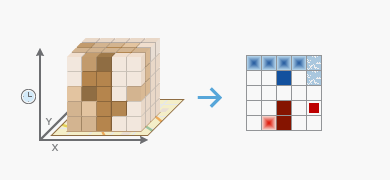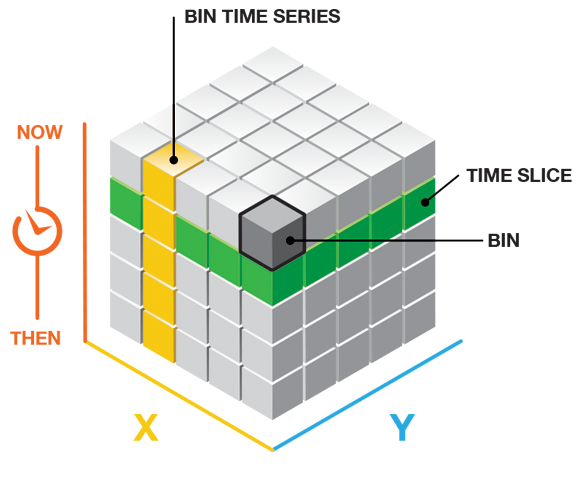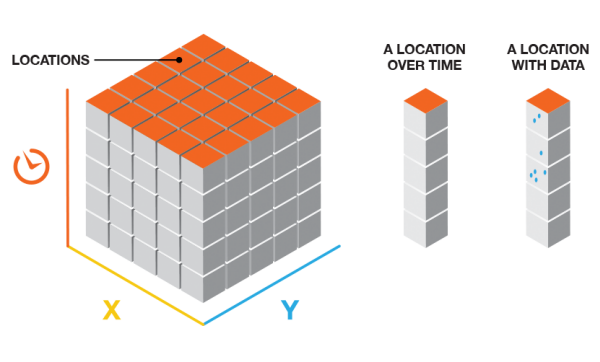Summary
Identifies trends in the clustering of point densities (counts) or summary fields in a space-time cube created using the Create Space Time Cube tool. Categories include new, consecutive, intensifying, persistent, diminishing, sporadic, oscillating, and historical hot and cold spots.
Learn more about how the Emerging Hot Spot Analysis tool works
Illustration

Usage
This tool can only accept netCDF files created by the Create Space Time Cube tool.
Each bin in the space-time cube has a LOCATION_ID, a time_step_ID, a COUNT value, and any Summary Fields that were aggregated when the cube was created. Bins associated with the same physical location will share the same location ID and together will represent a time series. Bins associated with the same time-step interval will share the same time-step ID and together will comprise a time slice. The count value for each bin reflects the number of points that occurred at the associated location within the associated time-step interval.

This tool analyzes a variable in the netCDF Input Space Time Cube using a space-time implementation of the Getis-Ord Gi* statistic.
The Output Features will be added to the Table Of Contents with rendering that summarizes results of the space-time analysis for all locations analyzed. If you specify a Polygon Analysis Mask, the locations analyzed will be those that fall within the analysis mask; otherwise, the locations analyzed will be those with at least one point for at least one time-step interval.

In addition to the Output Features, an analysis summary is written to the Results window. Right-clicking the Messages entry in the Results window and selecting View will display the analysis summary in a Message dialog box. The analysis summary will also be displayed in the progress dialog box.
The Emerging Hot Spot Analysis tool can detect eight specific hot or cold spot trends: new, consecutive, intensifying, persistent, diminishing, sporadic, oscillating, and historical. See Learn more about how the Emerging Hot Spot Analysis tool works for output category definitions and additional information about the algorithms this tool employs.
To get a measure of the intensity of feature clustering, this tool uses a space-time implementation of the Getis-Ord Gi* statistic, which considers the value for each bin within the context of the values for neighboring bins. A bin is considered a neighbor if its centroid falls within the Neighborhood Distance and its time interval is within the Neighborhood Time Step you specify. When you do not provide a Neighborhood Distance value, one is calculated for you based on the spatial distribution of your point data. When you do not provide a Neighborhood Time Step value, the tool uses a default value of 1 time-step interval.
To determine which bins will be included in each analysis neighborhood, the tool first finds neighboring bins that fall within the specified Neighborhood Distance. Next, for each of those bins, it includes bins at those same locations from N previous time steps, where N is the Neighborhood Time Step value you specify.
The Neighborhood Time Step value is the number of time-step intervals to include in the analysis neighborhood. If the time-step interval for your cube is three months, for example, and you specify 2 for the Neighborhood Time Step, all bin counts within the Neighborhood Distance, and all of their associated bins for the previous two time-step intervals (covering a nine-month time period) will be included in the analysis neighborhood.
The Polygon Analysis Mask feature layer may include one or more polygons defining the analysis study area. These polygons indicate where point features could possibly occur and should exclude areas where points would be impossible. If you were analyzing residential burglary trends, for example, you might use the Polygon Analysis Mask to exclude a large lake, regional parks, or other areas where there aren't any homes.
The Polygon Analysis Mask is intersected with the extent of the Input Space Time Cube and will not extend the dimensions of the cube.
If the Polygon Analysis Mask that you are using to set your study area covers an area beyond the extent of the input features that were used when initially creating the cube, you may want to re-create your cube using that Polygon Analysis Mask as the Output extent environment. This will ensure that all of the area covered by the Polygon Analysis Mask is included when running the Emerging Hot Spot Analysis tool. Using the Polygon Analysis Mask as the Output extent environment setting during cube creation will ensure that the extent of the cube matches the extent of the Polygon Analysis Mask.
Running Emerging Hot Spot Analysis adds some analysis results back to the netCDF Input Space Time Cube. Three analyses are performed:
- Each bin is analyzed within the context of neighboring bins to measure how intense clustering is for both high and low values. The result from this analysis is a z-score, p-value, and binning category for every bin in the space-time cube.
- The time series of these z-scores at the locations analyzed is then assessed using the Mann-Kendall statistic. The result from this analysis is a clustering trend z-score, p-value, and binning category for each location.
- Finally, the time series of the values at the locations analyzed is assessed using the Mann-Kendall statistic. The result from this analysis is a trend z-score, p-value, and binning category for each location.
A summary of the variables added to the Input Space Time Cube is given below:
Variable Name Description Dimension EMERGING_{ANALYSIS_VARIABLE}_HS_PVALUE
Getis-Ord Gi* statistic p-value measuring the statistical significance of high value (hot spot) and low value (cold spot) clustering.
Three dimensions: one p-value for every bin in the space-time cube.
EMERGING_{ANALYSIS_VARIABLE}_HS_ZSCORE
Getis-Ord Gi* statistic z-score measuring the intensity of high value (hot spot) and low value (cold spot) clustering.
Three dimensions: one z-score for every bin in the space-time cube.
EMERGING_{ANALYSIS_VARIABLE}_HS_BIN
The result category used to classify each bin as a statistically significant hot or cold spot value. The bin is based on an FDR correction.
- -3: cold spot, 99 percent confidence
- -2: cold spot, 95 percent confidence
- -1: cold spot, 90 percent confidence
- 0: not a statistically significant hot or cold spot
- 1: hot spot, 90 percent confident
- 2: hot spot, 95 percent confident
- 3: hot spot, 99 percent confident
Three dimensions: one binning category for every bin in the space-time cube. The bin is based on an FDR correction.
{ANALYSIS_VARIABLE}_TREND_PVALUE
The Mann-Kendall p-value measuring statistical significance of the trend in values at a location.
Two dimensions: one p-value for each location analyzed.
{ANALYSIS_VARIABLE}_TREND_ZSCORE
The z-score measuring the Mann-Kendall trend, up or down, associated with the values at a location. A positive z-score indicates an upward trend; a negative z-score indicates a downward trend.
Two dimensions: one z-score for each location analyzed.
{ANALYSIS_VARIABLE}_TREND_BIN
The result category used to classify each location as having a statistically significant upward or downward trend for the values.
- -3: down trend, 99 percent confidence
- -2: down trend, 95 percent confidence
- -1: down trend, 90 percent confidence
- 0: no significant trend
- 1: up trend, 90 percent confident
- 2: up trend, 95 percent confident
- 3: up trend, 99 percent confident
Two dimensions: one binning category for each location analyzed.
EMERGING_{ANALYSIS_VARIABLE}_TREND_PVALUE
The Mann-Kendall p-value measuring statistical significance of the trend in hot/cold spot z-scores at a location.
Two dimensions: one p-value for each location analyzed.
EMERGING_{ANALYSIS_VARIABLE}_TREND_ZSCORE
The z-score measuring the Mann-Kendall trend, up or down, associated with the trend in hot/cold spot z-scores at a location. A positive z-score indicates an upward trend; a negative z-score indicates a downward trend.
Two dimensions: one z-score for each location analyzed.
EMERGING_{ANALYSIS_VARIABLE}_TREND_BIN
The result category used to classify each location as having a statistically significant upward or downward trend for hot/cold spot z-scores.
- -3: down trend, 99 percent confidence
- -2: down trend, 95 percent confidence
- -1: down trend, 90 percent confidence
- 0: no significant trend
- 1: up trend, 90 percent confident
- 2: up trend, 95 percent confident
- 3: up trend, 99 percent confident
Two dimensions: one binning category for each location analyzed.
EMERGING_{ANALYSIS_VARIABLE}_CATEGORY
One of 17 categories, 1 to 8, 0, and -1 to -8.
- 1, new hot spot
- 2, consecutive hot spot
- 3, intensifying hot spot
- 4, persistent hot spot
- 5, diminishing hot spot
- 6, sporadic hot spot
- 7, oscillating hot spot
- 8, historical hot spot
- 0, no pattern detected
- -1, new cold spot
- -2, consecutive cold spot
- -3, intensifying cold spot
- -4, persistent cold spot
- -5, diminishing cold spot
- -6, sporadic cold spot
- -7, oscillating cold spot
- -8, historical cold spot
Two dimensions: one category for each location analyzed.
Syntax
EmergingHotSpotAnalysis(in_cube, analysis_variable, output_features, {neighborhood_distance}, {neighborhood_time_step}, {polygon_mask})| Parameter | Explanation | Data Type |
in_cube | The netCDF cube to be analyzed. This file must have an (.nc) extension and must have been created using the Create Space Time Cube tool. | File |
analysis_variable | The numeric variable in the netCDF file you want to analyze. | String |
output_features | The output feature class results. This feature class will be a two-dimensional map representation of the hot and cold spot trends in your data. It will show, for example, any new or intensifying hot spots. | Feature Class |
neighborhood_distance (Optional) | The spatial extent of the analysis neighborhood. This value determines which features are analyzed together in order to assess local space-time clustering. | Linear Unit |
neighborhood_time_step (Optional) | The number of time-step intervals to include in the analysis neighborhood. This value determines which features are analyzed together in order to assess local space-time clustering. | Long |
polygon_mask (Optional) | A polygon feature layer with one or more polygons defining the analysis study area. You would use a polygon analysis mask to exclude a large lake from the analysis, for example. Bins defined in the Input Space Time Cube that fall outside of the mask will not be included in the analysis. | Feature Layer |
Code sample
EmergingHotSpotAnalysis example 1 (Python window)
The following Python window script demonstrates how to use the EmergingHotSpotAnalysis tool.
import arcpy
arcpy.env.workspace = r"C:\STPM"
arcpy.EmergingHotSpotAnalysis_stpm("Homicides.nc", "COUNT", "EHS_Homicides.shp", "5 Miles", 2, "#")
EmergingHotSpotAnalysis example 2 (stand-alone Python script)
The following stand-alone Python script demonstrates how to use the EmergingHotSpotAnalysis tool.
# Create Space Time Cube of homicide incidents in a metropolitan area
# Import system modules
import arcpy
# Set property to overwrite existing output, by default
arcpy.env.overwriteOutput = True
# Local variables...
workspace = r"C:\STPM"
try:
# Set the current workspace (to avoid having to specify the full path to the feature
# classes each time)
arcpy.env.workspace = workspace
# Create Space Time Cube of homicide incident data with 3 months and 3 miles settings
# Process: Create Space Time Cube
cube = arcpy.CreateSpaceTimeCube_stpm("Homicides.shp", "Homicides.nc", "MyDate", "#",
"3 Months", "End time", "#", "3 Miles", "Property MEDIAN SPACETIME; Age STD ZEROS",
"HEXAGON_GRID")
# Create a polygon that defines where incidents are possible
# Process: Minimum Bounding Geometry of homicide incident data
arcpy.MinimumBoundingGeometry_management("Homicides.shp", "bounding.shp", "CONVEX_HULL",
"ALL", "#", "NO_MBG_FIELDS")
# Emerging Hot Spot Analysis of homicide incident cube using 5 Miles neighborhood
# distance and 2 neighborhood time step to detect hot spots
# Process: Emerging Hot Spot Analysis
cube = arcpy.EmergingHotSpotAnalysis_stpm("Homicides.nc", "COUNT", "EHS_Homicides.shp",
"5 Miles", 2, "bounding.shp")
except arcpy.ExecuteError:
# If any error occurred when running the tool, print the messages
print(arcpy.GetMessages())
Environments
Licensing information
- ArcGIS Desktop Basic: Yes
- ArcGIS Desktop Standard: Yes
- ArcGIS Desktop Advanced: Yes